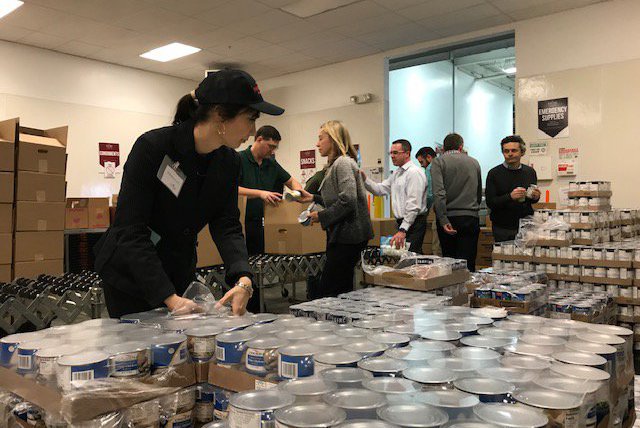
July 21, 2022
 Provided images/Food Bank of South Jersey
Provided images/Food Bank of South Jersey
Food security increased by 10% in Southeastern Pennsylvania and New Jersey during 2020, the first year of the COVID-19 pandemic, according to Feeding America's analysis. Above, people volunteer at the Food Bank of South Jersey.
The COVID-19 pandemic left many more Philadelphia residents without enough food to eat.
Feeding America's most recent Map the Meal Gap study, released Thursday, shows how the layoffs and supply chain issues wrought by the public health crisis impacted food access in every county in the United States in 2020.
Food insecurity rose more than 10% overall between 2019 and 2020 in the nine Southeastern Pennsylvania and South Jersey counties served by the food bank Philabundance, the analysis found. It increased by 25% among people age 18 and under.
The situation in Philadelphia was worse than any other county in Pennsylvania. In the city, 15.8% of the its population, or about 250,000 people, struggled with hunger in 2020. That was up from 14.4% in 2019. And it was well higher than the state and national marks of 8.9% and 11.8%, respectively.
More than 100,000 children in Philadelphia, or 30.9% of its child population, experienced food insecurity, up from 24.2% in 2019, more than double the 13.1% recorded in Pennsylvania.
The analysis marked the first time the Map the Meal Gap study examined how rates varied across racial and ethnic groups.
In Philadelphia, 23% of Black people and 25% of Hispanic people experienced food insecurity, whereas only 10% of white people did.
The gap between ethnic and racial groups in Philadelphia is similar to what was seen in Pennsylvania, where 22% of Black people, 21% of Hispanic people and 7% of white people experienced food insecurity.
The situation is less severe in Philadelphia's suburban counties. Bucks, Chester, Delaware and Montgomery counties all had rates of less than 10%. Delco had the highest, with 9.1%.
In Upper Darby, Delaware County, Murphy's Giving Market – a food bank partnered founded in 2018 – is struggling to get by.
Demand has increased "exponentially" since 2020, said Desiree LaMarr Murphy, the food bank's executive director.
Because her organization is focused on "culturally relevant, sensitive food," the standard donations of canned beans, spaghetti and pasta sauce only goes so far.
"We need people to donate cash or gift cards," she said.
Although the Map the Meal Gap study doesn't include any data about Asian Americans, Murphy said they constitute 70% of her organization's client base. Most are immigrant families from Bangladesh and elsewhere in South Asia. Many are vegetarian or halal, which makes it harder for Murphy to get them the food they need.
She said most food banks across the Philadelphia region are similarly strained and in desperate need of financial donations and volunteers. There's also a huge need for diapers and baby formula donations.
Nowhere in New Jersey had food insecurity rates as high as Philadelphia, but the effects of the pandemic on food access can be felt there, too.
In Atlantic County 15.1% of residents experienced food insecurity in 2020, more than anywhere else in the state, the Feeding America study found.
Though the study examined how the pandemic decreased access to food nationwide in 2020, it's not clear whether the economic recovery that followed improved the situation.
Philabundance and Feeding America take their time processing the most recent data to ensure their analysis is accurate. They plan to release their findings for 2021 in September, a Philabundance spokesperson said.
But pulse surveys from the U.S. Census Bureau affirm Murphy's observation that the crisis has gotten worse.
Last year, 11% of Pennsylvania residents experienced food scarcity Between July 29 and Aug. 11, up from 7.3% in August 2020, pulse surveys show. The rate in metro Philadelphia for the same period was 11.4%, up from 8.3% in August 2020.
There's also a strong relationship between poverty and food insecurity.
The poverty rate in the U.S. was at 14.1% in May, down from the pandemic peak of 17.3% recorded in August 2020, the Center on Policy & Social Policy at Columbia University reported. But the rate has risen steadily since March 2022, when it was at just 10.8%.